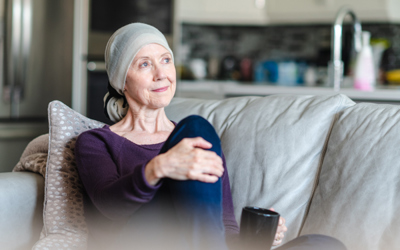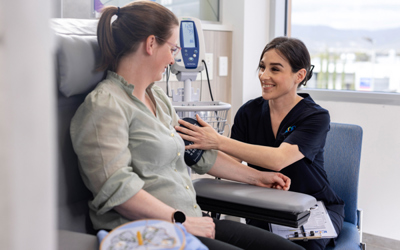Quick facts about bone cancer
Bone cancer can begin in any bone in the body and may develop from the centre of the bone, on the surface of the bone or on the outer layer of the bone
Primary bone cancer is different to secondary (or metastatic) bone cancer, which refers to a cancer that started somewhere else in the body and has spread to the bones
Bone cancer is rare in both Australian men and women, with approximately 250 Australians diagnosed each year. It is more commonly seen in children, adolescents and young adults
Types of bone cancer
There are more than 30 types of primary bone cancer. The most common types of bone cancer include:
-
Osteosarcoma
This type of bone cancer affects the cells which grow bone tissue. Osteosarcoma is fast-growing and often develops in the long bones (arms or legs) but can start in any bone. It accounts for approximately 35% of bone cancers and is most common in children and young adults with growing bones or adults over 70 years of age.
-
Chondrosarcoma
This type of bone cancer grows in the cartilage. Chondrosarcoma is slow-growing and often develops in the pelvis, ribs, shoulder blade, upper arms or legs. It accounts for approximately 30% of bone cancers and is most common in adults over 50 years of age.
-
Ewing’s sarcoma
Ewing’s sarcoma grows in the bones or in the soft tissue around the bones. This type of bone sarcoma is fast-growing and often develops in the spine, legs, upper arms, pelvis and ribs. Ewing’s sarcoma accounts for approximately 15% of bone cancers and is most common in children and young adults.
Signs and symptoms of bone cancer
As signs and symptoms for bone cancer can be similar to other common conditions such as arthritis and osteoporosis, it’s important to see your GP or healthcare professional if you experience any of the symptoms below. Discussing anything concerning as soon as possible can help give you peace of mind and offer the best chance of successful treatment if you receive a bone cancer diagnosis.
Symptoms may include:

Pain the bones and joints that may worsen at night or during activity

Swelling over the affected part of the bone

Stiffness or tenderness in the bone

Problems with movement such as an unexplained limp

A fractured bone, even with no or minimal trauma

Unexplained weight loss
Stages of bone cancer
The TNM system is used to stage bone cancer and define what your cancer looks like. TNM stands for:
Tumour – Describes the size of the tumour. The tumour can be graded from T1 (describing a tumour 8cm or less), T2 (describing a tumour larger than 8cm) or T3 (there is more than one separate tumour in the bone). This stage applies to osteosarcoma which often develops in the long bones of the arms or legs
Node – Is a measure of whether the tumour has spread to nearby lymph nodes. Nodes can be graded from N0, where there has been no spread, through to N1, where the cancer has spread to the lymph nodes. It is rare for primary bone cancer to spread to the lymph nodes
Metastasis – The degree to which the cancer has spread to other organs of the body. Metastasis can be graded from M0, where there has been no spread, through to M1, where the cancer has spread to other organs of the body and formed additional tumours
Bone cancer is also given a grade to determine how quickly it will grow. Bone cancers with a higher grade are more aggressive and have a higher likelihood of growing and spreading faster compared to those with a lower grade.
-
Low grade
The cancer cells in the bone are slow growing and tend not to spread
-
High grade
The cancer cells look very different compared to healthy bone cells and tissue, and tend to grow and spread more quickly
The TNM system, along with the grading, helps determine the stage of your bone cancer using the guidelines below:
-
Stage I
A single low grade tumour that has not spread beyond the bone to the lymph nodes or other organs of the body.
-
Stage II
A single high grade tumour that has not spread beyond the bone to the lymph nodes or other organs of the body.
-
Stage III
Several high grade tumours in the same bone that has not spread beyond the bone to the lymph nodes or other organs of the body.
-
Stage IV
The tumour may be any size or grade and has spread to the lymph nodes and other organs of the body.
Treatment for bone cancer
There are many different types of treatment for bone cancer. Your treatment will depend on you and your cancer.




